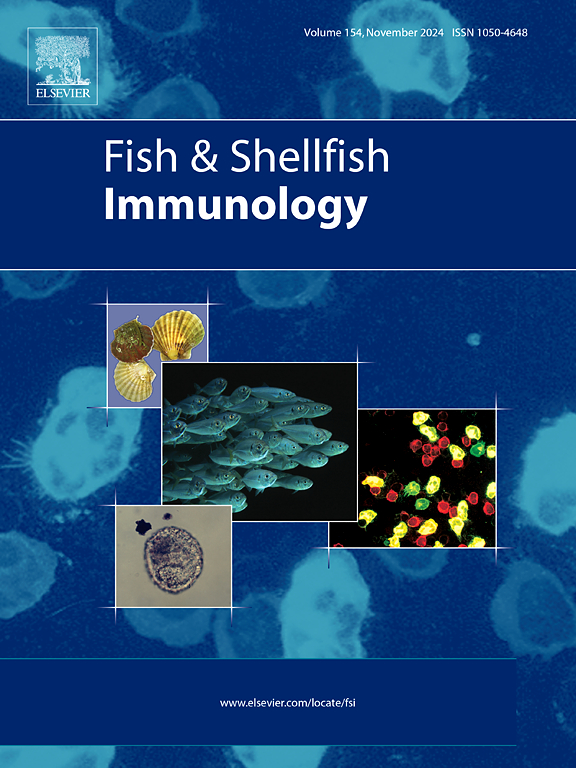志贺氏单胞菌感染诱导锯齿鳗肝胰腺铁下垂和细胞凋亡。
IF 3.9
2区 农林科学
Q1 FISHERIES
引用次数: 0
摘要
锯齿鳗(Mastacembelus armatus)是中国南方重要的商业鱼类,但其对志贺氏单胞菌(P. shigelloides)感染的易感性尚不清楚。本研究以100 μL YY001 (1 × 109 CFU/mL)腹腔感染锯齿鳗,观察其对锯齿鳗肝胰腺的影响。肝胰腺组织病理学分析显示出血、组织松动、细胞间隙增大、细胞空泡增多。转录组学分析鉴定出5508个差异表达基因(deg),在免疫和代谢途径中显著富集,特别是在铁下垂和细胞凋亡途径中,这些基因在感染组中表达上调。随后,我们通过生化分析、TUNEL染色和qPCR证实了这些发现。结果表明,感染后鼠肝胰脏GPX活性显著降低,铁离子(Fe)浓度和丙二醛(MDA)浓度显著升高。此外,感染后鼠肝胰脏gpx4和scl7a11基因表达显著下调,而铁下垂标志基因lpcat3和ncoa4表达显著上调。这些结果表明,感染志贺氏杆菌后,鼠肝胰脏细胞发生铁下垂。TUNEL染色结果显示,感染志贺氏单胞杆菌后,锯齿鳗肝胰腺细胞发生凋亡,凋亡基因casp3、casp8、bax基因表达显著上调,凋亡抑制基因bcl2表达显著下调。以上结果提示,志贺氏杆菌感染可引起锯齿鳗肝胰脏铁下垂和细胞凋亡,导致肝胰脏病变。我们的研究为志贺杆菌引起的鱼类疾病的发病机制提供了新的见解。本文章由计算机程序翻译,如有差异,请以英文原文为准。
Plesiomonas shigelloides infection induced ferroptosis and apoptosis in hepatopancreas of zig-zag eel (Mastacembelus armatus)
The zig-zag eel (Mastacembelus armatus) is a commercially important fish species in southern China, yet its susceptibility to Plesiomonas shigelloides (P. shigelloides) infection remains poorly understood. In this study, 100 μL of YY001 (1 × 109 CFU/mL) was used to intraperitoneally infect the zig-zag eel, and its effect on the hepatopancreas of the M. armatus was observed. The histopathology analysis of hepatopancreas revealed hemorrhage, tissue loosening, enlarged intercellular spaces, and increased cellular vacuolation. Transcriptomic profiling identified 5508 differentially expressed genes (DEGs), with significant enrichment in immune and metabolic pathways, especially in ferroptosis and apoptosis pathways, and these genes were upregulated in the infection group. Subsequently, we confirmed these findings through biochemical assays, TUNEL staining and qPCR. The results showed that GPX activity in hepatopancreas of M. armatus was significantly decreased, and iron ion (Fe) concentration and malondialdehyde (MDA) were significantly increased after infection. Furthermore, the results of gpx4 and scl7a11 genes expression in hepatopancreas of the M. armatus was significantly downregulated after infection, while the expression of ferroptosis marker genes lpcat3 and ncoa4 was significantly up-regulated. These results indicate that ferroptosis occurred in the hepatopancreas cells of the M. armatus after infection with P. shigelloides. The results of TUNEL staining showed that after infection with P. shigelloides, apoptosis occurred in the hepatopancreatic cells of the zig-zag eel, and the expressions of the apoptosis genes casp3, casp8, and bax genes were significantly upregulated, while the expression of the apoptosis inhibitor gene bcl2 was significantly downregulated. These results all indicate that P. shigelloides infection can cause ferroptosis and apoptosis in the hepatopancreas of the zig-zag eel, leading to hepatopancreatic lesions. Our study provides new insights into the pathogenesis of fish diseases caused by P. shigelloides.
求助全文
通过发布文献求助,成功后即可免费获取论文全文。
去求助
来源期刊

Fish & shellfish immunology
农林科学-海洋与淡水生物学
CiteScore
7.50
自引率
19.10%
发文量
750
审稿时长
68 days
期刊介绍:
Fish and Shellfish Immunology rapidly publishes high-quality, peer-refereed contributions in the expanding fields of fish and shellfish immunology. It presents studies on the basic mechanisms of both the specific and non-specific defense systems, the cells, tissues, and humoral factors involved, their dependence on environmental and intrinsic factors, response to pathogens, response to vaccination, and applied studies on the development of specific vaccines for use in the aquaculture industry.
 求助内容:
求助内容: 应助结果提醒方式:
应助结果提醒方式:


